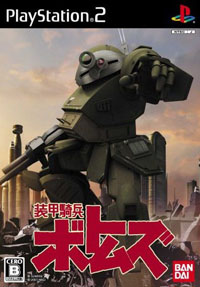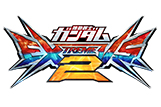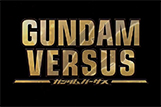Reviews: Soukou Kihei VOTOMS (8/10)
Posted on : 03-09-2009 | By : Cacophanus | In : Reviews
Hardware: PlayStation 2
0
 There are a few anime series tie-ins that are almost always functional travesties when it comes to gaming adaptations. One of those has been Ryosuke Takahashi’s Soukou Kihei VOTOMS. Every single game has treated Armored Trooper (AT) combat with a fastidiously rigid approach and missed the actual functional parameters of the mecha themselves. The problem lies with the Scopedog, the Gilgamesh’s multi-purpose and mass-produced AT.
There are a few anime series tie-ins that are almost always functional travesties when it comes to gaming adaptations. One of those has been Ryosuke Takahashi’s Soukou Kihei VOTOMS. Every single game has treated Armored Trooper (AT) combat with a fastidiously rigid approach and missed the actual functional parameters of the mecha themselves. The problem lies with the Scopedog, the Gilgamesh’s multi-purpose and mass-produced AT.
In each of the AT’s feet you have hidden wheels that, once engaged, allow the mecha to effectively roller-skate at high speeds. In the series, the momentum of the AT has a direct role in how the mecha “banks” into corners, but the literal idiocy that ensues is down to the fact that, in the anime, the mecha are manually driven. This means tracking a target and rolling are controlled independently. Now in an AT you have sticks and pedals, so this approach makes sense. The sticks control the torso, turning and target tracking, but the pedals handle the rollers. All of this fits with that control setup, but mapping that directly to a pad will produce the functional equivalent of wrestling with a ferret. It’s overly complex and incredibly frustrating, something that multiple PS1 games have confirmed on numerous occasions.
When a new VOTOMS series was announced, that of the wondrous Pailsen Files, many were awaiting the inevitable news of a gaming tie-in. The news did eventually surface, but things seemed different this time. First off, Yuke’s were handling the development, rather than the awful in-house Takara development teams, and second was that the screenshots indicated that this could actually work on a pad.
What Yuke’s did was logically obvious: merge the tracking and roller control into one scheme that did both simultaneously. This now means the rollers obey whatever target you are currently locked on to, so you can skate around a target with exquisite ease. This isn’t to say Yuke’s made the game easy, as a lot of it is incredibly difficult, but this time the difficulty is not due to the idiotic controls, but instead due to the fact you’re piloting a fragile, though powerful, robot against similarly potent enemies.
Piloting it you are as well, as this game allows you to exit your AT as the series’ protagonist Chirico Cuvie, and roam the environment on foot. You can even enter other abandoned ATs found on the stages as well. So whilst you may be down in a fight you are by no means ever out.
The main campaign follows the events of the series, from Uoodo to Kummen then Sunsa and finally the mysterious planet of Quent. Each part has a narrative path which completes the section, but in addition to this you also have ancillary missions where you can earn more money to buy further ATs. You are also awarded more money depending on your final mission rank — attaining the lofty S Rank on most missions is a herculean task, but can also pay greater dividends as certain prototype ATs become available in the shop.
Actual combat can be switched between first and third person. In the latter you have a lock-on function but one that has to be visually acquired, so if an enemy zips behind cover you lose your lock. The game defaults to an auto-lock anyway, so this isn’t overly awkward to manage.
The ATs also retain their momentum, so you do have to manage that, and if you travel too fast into an object when rolling you will be knocked over. So negotiating the environment and keeping track of a target is very much a tactile endeavour. You also have to contend with the ballistic arc of some weapons — getting a good firing position whilst rolling takes skill (especially against the faster ATs). You can also resort to the arm punch when up close, as well as pick up alternate weapons mid-mission, so you’re never left entirely defenceless.
In addition to all this, the ATs also have the “Mission Disks” from the series. These are a selection of special moves that have to initiated and held within certain ranges. So special melee moves are quick to start but need to be up close. These can also be interrupted if you either crash into scenery or get hit. They can turn the tide of certain boss fights, but they are risky to use and have to be undertaken with care.
The game also covers the entire original TV series narrative as well as its multitudinous OVA-based progeny (bar Mellowlink, though there are a few missions on Sunsa that have you take out ATs just on foot, which was a nice nod). You even get a Blue Knight side-story mission, which is incredible considering how niche the original manga was.
There’s so much this game gets right, from how the ATs handle, to hitting the beats of the original anime’s narrative. The only real downside to the whole thing is that the environments can be quite spartan and simplistic. They’re also overused in some sections. Obviously, the priority was to model all the various ATs and other enemies you face. So the heavy task of creating richer and more involved environments fell by the wayside.
Overall, even if you know nothing about VOTOMS, let alone mecha gaming, you’ll appreciate the wonderful job Yuke’s have done of creating a consistent handling ruleset for the ATs in this game. The sheer visceral thrill of speeding through a dangerous troupe of equally lethal enemy ATs whilst literally dancing around them is quite wonderful indeed.
Tamashii: 8/10










